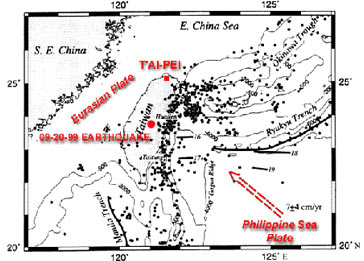180410-typhoon.jpg

Earthquakes with magnitude greater than or equal to 5.0, occurring between 1964 and 1995. Credit: U.S. Geological Survey.
It’s hard to think of a typhoon as a life-saver. In the western Pacific, these giant storms kill thousands every year, and cause billions of dollars in damage. Yet in Taiwan, they may actually save lives: Research shows they may help prevent monster earthquakes.
“Typhoon” is just another name for a hurricane. It’s a giant tropical storm that can pack strong winds, heavy rains, and a massive storm surge -- not something you want to mess with.
But researchers found something amazing. They were measuring stresses along a fault line in eastern Taiwan -- the junction of two of the thin plates of rock that make up Earth’s crust. The plates move, but not smoothly. Friction causes them to stick together. That causes pressure to build up between them -- pressure that often releases itself in a few seconds as a powerful earthquake.
The scientists measured 20 “slow” quakes -- those that release their energy over hours instead of in one intense jolt. Because they release energy slowly, they don’t cause any damage. In fact, no one even feels them. They ease the pressure along the fault line, though, which reduces the risk of killer quakes later on.
The “amazing” part was that researchers found that 11 of the slow quakes occurred during typhoons. The low air pressure in a typhoon may allow one side of the fault line to slowly “unclamp” a bit, creating a “slow” quake. If that’s the case, then big storms on the ocean just may help prevent big storms in Earth’s crust.

